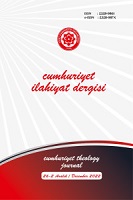Âlî İsnad Arayışlarının Meyvesi: es-Sâbık ve’l-Lâhik
The Result of the Search for Elevated Isnād: al- Sābiq wa’l-Lāhiq
Author(s): Tuğçe GÜNAYDINSubject(s): 6th to 12th Centuries, History of Islam, Sociology of Religion, History of Religion
Published by: Cumhuriyet Üniversitesi İlahyat Fakültesi
Keywords: Isnād; Narration; Narrator; Elevated Isnād; al-Sābiq wa’l-lāhiq;
Summary/Abstract: This essay seeks to shed light on the connections between elevated isnād and al-sābiq wa’l-lāhiq (distance between the first and last narrator of traditionist). Since the 2 nd/8th century, when the search for elevated isnāds began, intense interest has been seen by the traditionists. The article looks at how these initiatives to elevated isnād helped pave the way for the emergence of alsābiq wa’l-lāhiq. Similarly, it is investigated if al-sābiq wa’l-lāhiq promotes the look for elevated isnād. First, the data documentation approach was applied to data taken from the history of hadith, various hadith techniques, and biographical dictionaries to ascertain the relationship between two notions. The relationship between two themes is then made clear using information from Khatīb Baghdādī’s (d. 463/1071) al-Sābiq wa’l-lāhiq, the first work authored in this field. Significance of the study of Khatīb Baghdādī’s work is further increased by the fact that he was the first to present the idea. The relationship between the subjects has been looked at in the article from three different theoretical angles. First, historical information has been used to assess how the orientation of hadiths concerning elevated isnād created the stage for the conception of al-sābiq wa’l-lāhiq. Then, the connection between subjects was examined through explanations of hadith methodology and biographical dictionaries authors. When the historical records of hadiths are reviewed, it becomes clear that the traditionist supported the hearing of elevated isnād and its transmission starting in the 2nd/8th century, particularly in the 3rd/9th and 4th/10th centuries. al-Sābiq wa’l-lāhiq was founded as a consequence of factors including the existence of grandfathers and grandchildren who reported from a single hadith due to orientation in elevated isnād and the fact that certain traditionists took pride in passing down the narrations of the elders to the younger generations. In addition, as the century moved away from the Prophet, the elevated isnāds that enable to reach him with a short isnād gained more importance. This situation explains why al-sābiq wa’l-lāhiq was formed in the 5th/11th century. It was also discovered that Khatīb Baghdādī’s introduction of this idea to the discussion was not a coincidence, and it was stated that this was due to his interest in elevated isnād. The connection established by the authors of hadith methodology between two concepts is that al-sābiq wa’l-lāhiq encourages the audition of elevated isnād. al-Lāhiq in other words hadith aspirants who want to be the last person who transmits hadith from a traditionist, that is, turning to mu‘ammerūn (long-lived) teachers at a young age supports the audition of elevated isnād. The efforts of biographical dictionaries authors to record elevated isnads that reached al-lāhiq were evaluated as a different manifestation of this situation. The connection between two subjects has also been examined in the work of Khatīb Baghdādī, which has the same name as the concept and various findings were obtained about al-sābiq wa’l-lāhiq and traditionists who were attributed to him as al-sābiq wa’l-lāhiq. According to this, it has been understood that traditionists who were compared to al-sābiq wa’l-lāhiq were chosen from among the long-lived people. A study was conducted on 6 traditionists, in whom Khatīb determined the ratio of al-sābiq wa’l-lāhiq to 10 or more. According to this, it has been determined that the narrators, who are mentioned as al-sābiq, are generally attributed to teachers or peers of traditionists. However, it has been revealed that there is no obligation to be a teacher or peer, and sometimes there are al-sābiqs among the students. The fact that most of the al-sābiqs are teachers and peers shows that the concept is considered a rarity. Because in the history of hadith, isnād generally goes from student to teacher. In addition, the narration of peers from each other or the teacher from students showed that narrators, who are called al-sābiq, have descending isnāds from that teacher. However, it has been determined that not all the narrations of al-sābiq were descending, only of whose narrations from that traditionist would be regarded as descending. As al-lāhiq, on the other hand, is the last person to transmit hadith from traditionist, he already has elevated isnād and all of them are long-lived people. However, the missing part of Khatīb’s book is that he does not pay attention to whether al-lāhiq is reliable or abandoned. In addition, it was stated that al-lāhiq should be chosen only from reliable, and in this case, it would not affect the distance between al-sābiq and al-lāhiq.
Journal: Cumhuriyet İlahiyat Dergisi
- Issue Year: 26/2022
- Issue No: 2
- Page Range: 903-915
- Page Count: 13
- Language: Turkish

